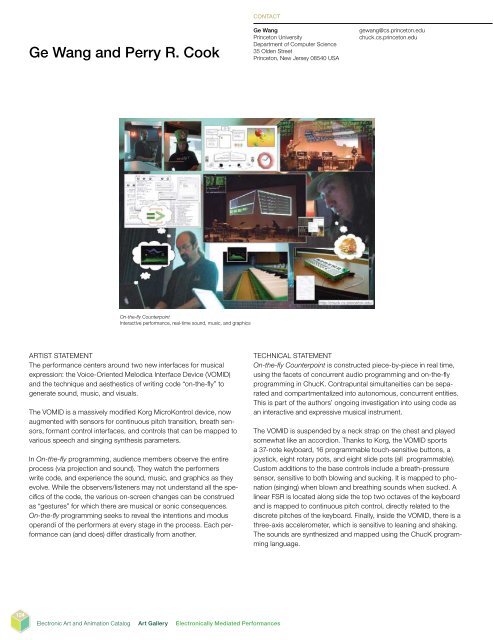Intersections - Nguyen Dang Binh
Intersections - Nguyen Dang Binh
Intersections - Nguyen Dang Binh
Create successful ePaper yourself
Turn your PDF publications into a flip-book with our unique Google optimized e-Paper software.
Ge Wang and Perry R. Cook<br />
On-the-fly Counterpoint<br />
Interactive performance, real-time sound, music, and graphics<br />
ARTIST STATEMENT<br />
The performance centers around two new interfaces for musical<br />
expression: the Voice-Oriented Melodica Interface Device (VOMID)<br />
and the technique and aesthestics of writing code “on-the-fly” to<br />
generate sound, music, and visuals.<br />
The VOMID is a massively modified Korg MicroKontrol device, now<br />
augmented with sensors for continuous pitch transition, breath sensors,<br />
formant control interfaces, and controls that can be mapped to<br />
various speech and singing synthesis parameters.<br />
In On-the-fly programming, audience members observe the entire<br />
process (via projection and sound). They watch the performers<br />
write code, and experience the sound, music, and graphics as they<br />
evolve. While the observers/listeners may not understand all the specifics<br />
of the code, the various on-screen changes can be construed<br />
as “gestures” for which there are musical or sonic consequences.<br />
On-the-fly programming seeks to reveal the intentions and modus<br />
operandi of the performers at every stage in the process. Each performance<br />
can (and does) differ drastically from another.<br />
CONTACT<br />
Electronic Art and Animation Catalog Art Gallery Electronically Mediated Performances<br />
Ge Wang<br />
Princeton University<br />
Department of Computer Science<br />
35 Olden Street<br />
Princeton, New Jersey 08540 USA<br />
gewang@cs.princeton.edu<br />
chuck.cs.princeton.edu<br />
TECHNICAl STATEMENT<br />
On-the-fly Counterpoint is constructed piece-by-piece in real time,<br />
using the facets of concurrent audio programming and on-the-fly<br />
programming in ChucK. Contrapuntal simultaneities can be separated<br />
and compartmentalized into autonomous, concurrent entities.<br />
This is part of the authors’ ongoing investigation into using code as<br />
an interactive and expressive musical instrument.<br />
The VOMID is suspended by a neck strap on the chest and played<br />
somewhat like an accordion. Thanks to Korg, the VOMID sports<br />
a 37-note keyboard, 16 programmable touch-sensitive buttons, a<br />
joystick, eight rotary pots, and eight slide pots (all programmable).<br />
Custom additions to the base controls include a breath-pressure<br />
sensor, sensitive to both blowing and sucking. It is mapped to phonation<br />
(singing) when blown and breathing sounds when sucked. A<br />
linear FSR is located along side the top two octaves of the keyboard<br />
and is mapped to continuous pitch control, directly related to the<br />
discrete pitches of the keyboard. Finally, inside the VOMID, there is a<br />
three-axis accelerometer, which is sensitive to leaning and shaking.<br />
The sounds are synthesized and mapped using the ChucK programming<br />
language.

















